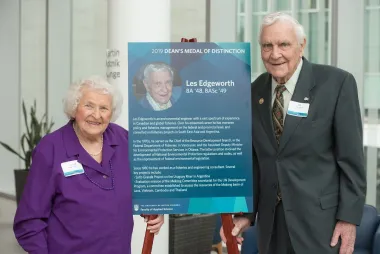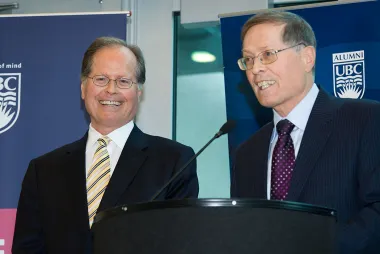Professor Emeritus Donates $2M to Create UBC Professorship in Critical Minerals Processing and Innovation

It was 1958 and George Poling faced the kind of work-life decision that many people face, regardless of the job.
After graduating from the University of Alberta, he had taken his first mining engineering job at the Roan Antelope Mine in Zambia—called Northern Rhodesia at the time. The underground mine churned out “blister copper” and George earned a bonus based on its selling price, a perk that initially amounted to 137 per cent of his base salary.
Only he and Verna, his longtime girlfriend back in Alberta, wanted to marry. Northern Rhodesia had also instituted compulsory military service for single men. “If I had to do military service,” he says, “I would rather do it back in Canada.”
So began George Poling’s ongoing career in mineral processing, 60 years that unfolded in the mining sector and transitioned to three decades as a professor before his third act as a consultant. Recently, the UBC Professor Emeritus made another life decision: to donate $2M to the Norman B. Keevil Institute of Mining Engineering, a generous contribution that has enabled the school to create the George Poling Professorship in Critical Minerals Processing and Innovation.
Critical minerals are more inextricably embedded in our technologies than ever
before, yet many are notoriously difficult to process and extract without damaging the environment. Over his career, George has not only forged mineral processing techniques intended to exact less harm to people and the planet, but has also taught young engineers the veritable ins and outs of this colossal challenge.
And the academic portion of his career began not long after he left Northern Rhodesia and met Verna in Venice to wed. Having “chosen a civil ceremony despite Italy being the centre of Roman Catholicism,” they soon learned their wedding would be delayed by at least a week because Pope Pius XII had just passed, grinding the country to a proverbial halt.
“After a week, we went to Rome to get married near the Colosseum. I forget why exactly, but we were wed by the Mayor of Rome, of all people.”
“Metals Do So Much Good for Us as Humans on Earth”
Though Verna, now deceased, had been George’s lifelong soulmate, “his first love,” he says, might’ve been electronics. At the age of 12, he earned his amateur radio operator’s license. Though he considered petroleum engineering after enrolling in electrical engineering at the University of Alberta, mining engineering required geology—a subject he enjoyed.
The main reason George pursued graduate work in mining engineering, however, was Jan Leja, a Polish-Canadian professor in mineral process engineering at U of A, who, unlike many of its unfortunate military captives, had managed to escape an infamous prisoner-of-war camp in remote Russia.
“I enjoyed working with Jan so much that Verna and I decided to stay in Edmonton and complete my PhD with Jan.”
At the time, Leja had been innovating froth flotation, a technique that separates critical elements from rock through a sort of bubbling distillation. George also learned “Scientific Russian” and translated a Soviet flotation textbook with his mentor.
“You could stack the pages this high.” George holds up his hand. “I’m talking several feet of documents.”
When Leja later accepted a teaching position at UBC, George would follow, teaching from 1968 to 1997 and becoming the Head of the Department of Mining and Mineral Process Engineering. With expertise in all things mineral processing, George also became one of Canada's leading experts in the environmental management of mining operations. A former Board of Director at BQE Water Inc. (a company specializing in smart mine water treatment), he also helped geologist Charles Fipke and Dia Met Minerals (later acquired by BHP Billiton) discover Ekati, North America's first commercial diamond mine.
“Mining is a subject not many people in the world know much about,” George says. “Yet it’s really essential that we have adequate supplies of metals because these materials do so much good for us as humans on earth.” Most of the globe couldn’t currently function, he adds, without the materials it pulls from the ground. Your phone, for example, requires a panoply of rare earth elements, each with its distinctive environmental footprint.
And this good that mineral can do? “That’s what’s always interested me most about mineral processing.”
What to Do with 400 Million Tons of Mining Waste?
It was exactly his interest in securing these minerals for future generations—in a way that protects people and the planet—that the UBC Professor Emeritus opted to give back to UBC and create the professorship that bears his name.
“One of the main changes over my career was the need to find new ways to treat these minerals without damaging the environment. These issues all grew steadily.” Over the decades, he points out that the increasing environmental consciousness in the 20th Century meant mining engineers needed to branch out, diversify and “learn to become environmental engineers.”
Consider the conundrum of what to do with 400 million tons of finely ground tailing solids. If the Island Copper Mine on Vancouver Island was to be approved by the BC government, tailings had to be safely buried somewhere with minimal adverse impact, and that required an independent monitoring program.
For over a century, mine tailings had been deposited under the seabed in much of the world, including Europe, Peru, the Philippines and North America, though on a smaller scale in Canada’s case. But all had varying adverse environmental impacts, at least in BC in the early 1970s, and never before had such an enormous quantity of tailings had to be dealt with. Not only the public and environmental groups but also the BC government itself expressed concern, understandably, about where the waste would be stored upon approval of the BHP Billiton mine.
“Most of the processed ore of any mine is waste,” George says, “and that waste is usually stored safely in on-land tailing impoundments.”
This is one of the difficult questions mining must consistently ask itself, given the complexity of ecosystems and mining’s history of human impact. For this reason, Port Hardy held a public hearing and Poling became a member and later “Chairman” of the Technical Environmental Advisory Committee for a team that included experts from UBC, Simon Fraser University and the University of Victoria. Years of peer-reviewed study were summarized in the peer-reviewed book that Poling and his colleagues wrote, Underwater Tailing Placement at Island Copper Mine: A Success Story. At the time of publication in 2002, many considered the study “the largest and most extensive studies on underwater tailing placement ever conducted.”
"A very detailed monitoring scheme had to be developed,” George says, alluding to all the years of chemical, biological, engineering and environmental study associated with the operation of the Island Copper Mine.
“You could stack the pages this high.” George holds up his hand. “I’m talking several feet of documents.” And now, he says, 54 years of detailed environmental monitoring results have assured both governments and the public that the mine has not adversely affected the environment of the mine-site area or marine inlet.
Canada has identified at least 34 “critical minerals” that are, according to the federal government, essential to the country’s economic national security. These minerals are “required for the national transition to a sustainable low-carbon and digital economy, and to position the country as a sustainable and strategic partner within global supply chains.”
“This action,” George says, “will receive government support to ensure our supply chain is not threatened.”
While the minerals are also essential to promoting our transition to greener energy and a digital economy, there is one overarching question: Where will our species store the ever-increasing waste associated with the increase in digital devices and human infrastructure? Given rising geopolitical tensions around the globe, George says, it will be incumbent upon future experts in critical minerals to “help secure a safe future for critical minerals here in Canada.”
The George Poling Professorship in Critical Minerals Processing and Innovation will work with industry and other researchers to help address this challenge. The professor will not only be given the resources and time to innovate new solutions but educate the next generation of interdisciplinary mining professionals.
“This professor will take on this challenge seriously. They will find new ways to process metals without hurting the environment, and help Canada secure critical minerals for future generations. That’s my hope.”



